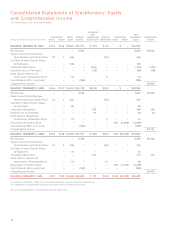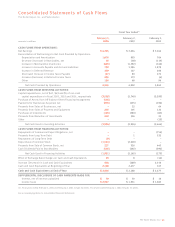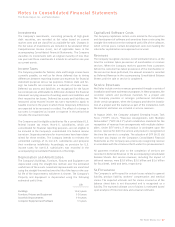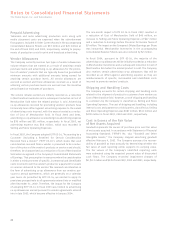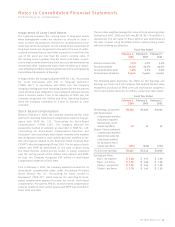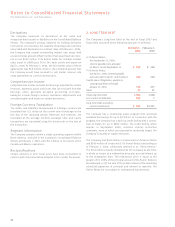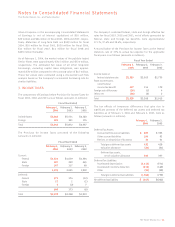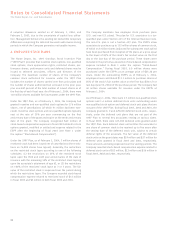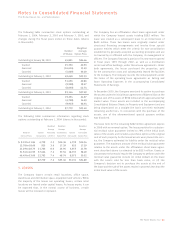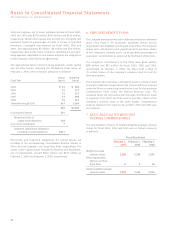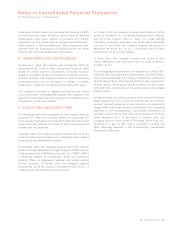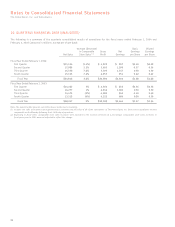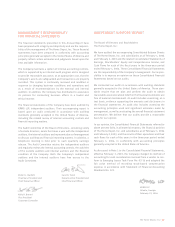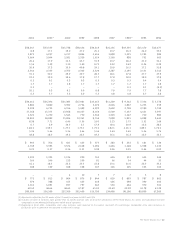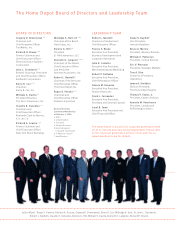Home Depot 2003 Annual Report Download - page 35
Download and view the complete annual report
Please find page 35 of the 2003 Home Depot annual report below. You can navigate through the pages in the report by either clicking on the pages listed below, or by using the keyword search tool below to find specific information within the annual report.
The Home Depot, Inc. | 33
Notes to Consolidated Financial Statements
The Home Depot, Inc. and Subsidiaries
The following table summarizes stock options outstanding at
February 1, 2004, February 2, 2003 and February 3, 2002, and
changes during the fiscal years ended on these dates (shares
in thousands):
Weighted
Number Average
of Shares Option Price
Outstanding at January 28, 2001 65,801 $26.46
Granted 25,330 40.33
Exercised (16,614) 15.03
Canceled (5,069) 39.20
Outstanding at February 3, 2002 69,448 $33.33
Granted 31,656 40.86
Exercised (9,908) 18.27
Canceled (8,030) 42.74
Outstanding at February 2, 2003 83,166 $37.09
Granted 19,234 24.97
Exercised (4,708) 16.03
Canceled (9,913) 38.54
Outstanding at February 1, 2004 87,779 $35.40
The following table summarizes information regarding stock
options outstanding at February 1, 2004 (shares in thousands):
Weighted Weighted Weighted
Average Average Average
Range of Options Remaining Outstanding Options Exercisable
Exercise Prices Outstanding Life (Yrs) Option Price Exercisable Option Price
$ 8.19 to 11.86 4,739 2.5 $10.36 4,739 $10.36
12.78 to 18.60 925 3.6 17.29 925 17.29
21.29 to 28.79 21,746 8.0 23.96 4,655 21.78
31.56 to 40.95 37,666 7.2 37.56 18,737 38.49
46.49 to 53.00 22,703 7.4 48.74 8,075 50.52
87,779 7.2 $35.40 37,131 $34.89
5. LEASES
The Company leases certain retail locations, office space,
warehouse and distribution space, equipment and vehicles. While
the majority of the leases are operating leases, certain retail
locations are leased under capital leases. As leases expire, it can
be expected that, in the normal course of business, certain
leases will be renewed or replaced.
The Company has an off-balance sheet lease agreement under
which the Company leased assets totaling $282 million. The
lease was created as a subsequent lease to an initial lease of
$600 million. These two leases were originally created under
structured financing arrangements and involve three special
purpose entities which meet the criteria for non-consolidation
established by generally accepted accounting principles and are
not owned by or affiliated with the Company, its management or
officers. The Company financed a portion of its new stores opened
in fiscal years 1997 through 2002, as well as a distribution
center and office buildings, under these lease agreements. Under
both agreements, the lessor purchased the properties, paid
for the construction costs and subsequently leased the facilities
to the Company. The Company records the rental payments under
the terms of the operating lease agreements as Selling and
Store Operating Expenses in the accompanying Consolidated
Statements of Earnings.
In December 2003, the Company exercised its option to purchase
the assets under the initial lease agreement of $600 million at the
original cost of the assets of $598 million which approximated fair
market value. These assets are included in the accompanying
Consolidated Balance Sheets in Property and Equipment and are
being depreciated on a straight-line basis over their estimated
remaining useful lives. In connection with the purchase of the
assets, one of the aforementioned special purpose entities
was dissolved.
The lease term for the remaining $282 million agreement expires
in 2008 with no renewal option. The lease provides for a substan-
tial residual value guarantee limited to 79% of the initial book
value of the assets and includes a purchase option at the original
cost of each property. As the leased assets were placed into serv-
ice, the Company estimated its liability under the residual value
guarantee. The maximum amount of the residual value guarantee
relative to the assets under the off-balance sheet lease agree-
ment described above is estimated to be $223 million. Events or
circumstances that would require the Company to perform under the
residual value guarantee include (1) initial default on the lease
with the assets sold for less than book value, or (2) the
Company’s decision not to purchase the assets at the end of
the lease and the sale of the assets results in proceeds less than the
initial book value of the assets.



